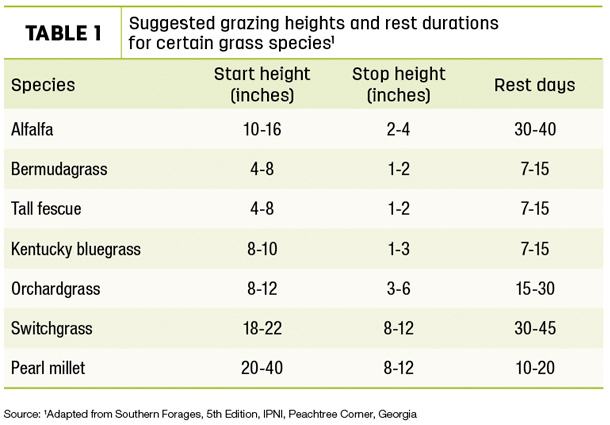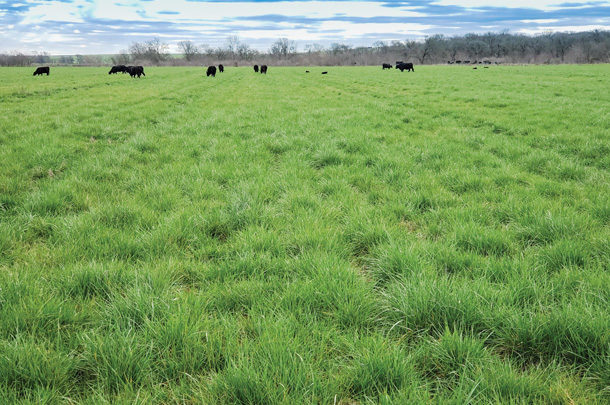Pasture forage for grazing can offer several benefits. If managed properly, it is the most cost-effective source of feed for cow-calf producers and other livestock operators. Grazing provides an opportunity to productively use marginal land not suitable for farming. Last but not least, properly grazed forages serve as a tool for conserving wildlife habitat and keeping prairie ecosystems healthy.
The first step in proper management of a pasture system is the design of a grazing plan that includes stocking rates and grazing periods for each pasture. During the design process, strengths and weaknesses of the current system become apparent, and areas that need improvement are highlighted. Amount of forage availability is limited by climate and soil type, and a grazing plan helps avoid overuse of the resource.
Dr. Monte Rouquette Jr., Texas A&M AgriLife Research, suggests the following questions to consider in drafting the grazing plan:
- What forages are present on the property and which are best adapted to the vegetation-climatic area?
- What are the fertility levels of the pastures and how much fertilizer, if any, is needed for the desired amount of forage production?
- What is the best stocking rate and which visual or measured indicator of forage availability will be used?
- Should hay be produced or purchased and what will determine if a supplemental protein or energy feed is needed?
- What are the seasonal nutritional needs of the livestock?
- How can a forage-livestock operation system provide a sustainable ecosystem that encourages wildlife food and habitat?
Pasture quality and productivity
“Good pasture condition is critical to a successful grazing system,” says Joe Armstrong, cattle production systems educator, University of Minnesota Extension. “Forage quality may vary from one pasture to another and from one area within a pasture to another. Forage grass and legume species each have their own unique growth, persistence and quality characteristics and respond differently to soil conditions, weather patterns, fertility and grazing management. Thus, evaluation of the entire system is important to the success of the grazing plan.”
The first step in designing the grazing plan is to either draw a map or use mapping software to show boundaries of land available for grazing. Identify land that is owned versus leased land. Certain management practices are practical for owned land but may not be economically feasible for leased or rented pastures. Determine number of acres in each pasture and note them on the map. Mapping can show if there is additional land available for grazing. Cropland next to pastureland may be better used for growing forages if pasture expansion is one of the goals.
“To determine and measure pasture quality, first walk through the pastures and survey what is there. Overall vegetative cover and density is rated as thin, average or thick,” says Armstrong. “If the same person consistently evaluates pastures in the same way each time, it is possible to develop and record pasture condition trends which indicate management needs. Identify dominant plant species and record them on the map. Help in plant identification is available from local extension offices, USDA service centers or smartphone apps. Collect representative samples of pasture vegetation and send to [a] competent forage laboratory for analysis of protein and mineral content.”
Many methods of estimating pasture productivity or forage mass are available. Some of the more technical methods include the use of equipment such as a rising plate meter, falling plate meter, infrared and drone. The simplest methods are pasture clipping and vegetation height measurement, which are very accurate. Regardless of the measurement method, pasture production is expressed in pounds of dry matter per acre.
The grazing system
Grazing systems vary from continuous grazing of one area to intensive grazing on small areas for short periods of time. Livestock systems involving continuous grazing can result in both overutilization and underutilization of forages. A rotational system provides an opportunity for forage plants to rest so they recover more quickly from grazing.
“A rotational system involves movement of livestock based on forage growth,” says Dr. Chris Teutsch, University of Kentucky. “It promotes better forage utilization and production, drought tolerance, strong nutrient cycles through improved distribution of dung and urine, an extended growing season and botanical composition.”
For successful implementation of a rotational grazing system, you must have the right attitude. You have got to want to do it, and flexibility is the key to make the system work. It may be as simple as opening a gate.
“Proper grazing intensity is a balance between wants and needs,” says Teutsch. “A stocking rate that is too high results in reduced animal and pasture production. If it is too low, money is lost. The producer has to decide what is optimum.”
“Amount of available forage dry matter and the amount of forage required by each animal and the herd as a whole is used to determine stocking density. The overall goal is to define the proper combination of land, grazing periods and number of animals to ensure sustained, long-term productivity of the pasture,” says Armstrong. “Optimum number of animals on a pasture makes efficient use of the forage without waste, yet leaves enough leaf matter to allow quick and complete plant recovery.”
Suggested grazing heights and rest durations for certain grass species are listed in Table 1.

Similar information for other species is available from university extension services. These criteria will vary due to weather, soil condition, exposure and other environmental factors.










